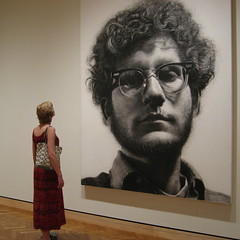As a full-fledged art movement, Photorealism evolved from Pop Art[1][2] and as a counter to Abstract Expressionism[3][4] as well as Minimalist art movements[5][6][7][8] in the late 1960s and early 1970s in the United States.[9]
It is also sometimes labeled as Super-Realism, New Realism, Sharp Focus Realism, or Hyper-Realism, says Wikipedia.org.[10] The Photorealist genre is predominately made up of painters. The word Photorealism was coined by Louis K. Meisel in 1968.
Photorealist painting cannot exist without the photograph. In Photorealism, change and movement must be frozen in time which must then be accurately represented by the artist.[14] Photorealists gather their imagery and information with the camera and photograph. Once the photograph is developed (usually onto a photographic slide) the artist will systematically transfer the image from the photographic slide onto canvases. Usually this is done either by projecting the slide onto the canvas or by using traditional grid techniques.[15] The resulting images are often direct copies of the original photograph but are usually larger than the original photograph or slide. This results in the photorealist style being tight and precise, often with an emphasis on imagery that requires a high level of technical prowess and virtuosity to simulate, such as reflections in specular surfaces and the geometric rigor of man-made environs.[16]
20th century photorealism can be contrasted with the similarly literal style found in trompe l'oeil paintings of the 19th century. However, trompe l'oeil paintings tended to be carefully designed, very shallow-space still-lifes, employing illusionistic devices such as the use of shadows to cause small objects to appear to exist above the surface of the painting. (Trompe l'oeil literally means "fool the eye.") The photorealism movement moved beyond this illusionism to tackle deeper spatial representations (e.g. urban landscapes) and took on much more varied and dynamic subject matter.

No comments:
Post a Comment